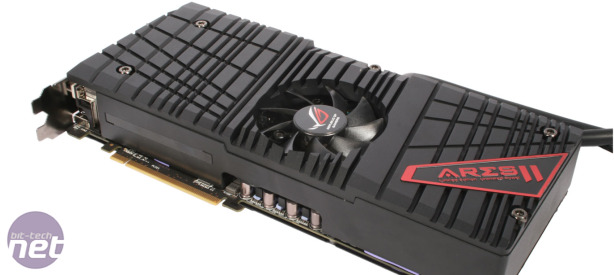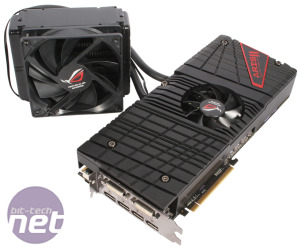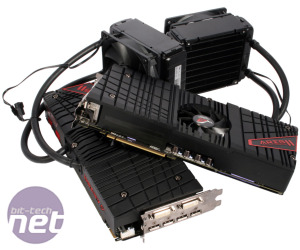
Performance Analysis
We've dropped the 1,920 x 1,080 tests for this card, but at both 2,560 x 1,600 and 5,760 x 1,080 in Battlefield 3 the Ares II is easily the fastest card. In both tests, it's 10fps quicker than the GTX 690 4GB and achieves more than double the minimum frame rate of a single GHz Edition HD 7970 3GB. In CrossFire, the two Asus cards achieve ludicrously high minimum frame rates of 149fps and 100fps respectively. Just because we could, we also ran tests across three high-res monitors for a total resolution of 7,680 x 1,440. Even one Ares II was enough to make this resolution playable, and a pair of them achieved over 60fps consistently, although some micro-stuttering was observed in this case.In Crysis 2, the Ares II maintained a minimum frame count of 76fps at 2,560 x 1,600, 18fps quicker than a GTX 690 4GB. Adding a second card only increased this by 5fps, but the average frame rate was much higher. Across three screens, a single Ares II matched the minimum result of the GTX 690 4GB, but the second card made a much bigger difference, scaling by 89 per cent to 70fps minimum. Our high resolution three screen test proved too much for a single card in this game, but with two in CrossFire the setup could cope with ease.
In Skyrim, the Asus card's performance is less impressive. A single card showed a high average frame rate at 2,560 x 1,600 but its minimum was still a whole 31fps below a GTX 690 4GB (although 6fps higher than the Club3D HD 7990 6GB). Adding a second card actually reduced the frame rates, suggesting that driver issues are limiting the effectiveness of CrossFire here. The GTX 690 4GB was again the faster card with triple screens, although not by as much, and unfortunately a second card again made for a dip in performance.
The 2,560 x 1,600 test in The Witcher 2 showed that performance was roughly equal whether we used one Ares II or two, and said performance left the card again trailing the GTX 690 4GB, demonstrating the particular importance of optimised drivers for such cards. We were also unable to run any three screen tests here. The game does not natively support CrossFire, and the widescreen hacks we usually use failed to work this time around no matter what we tried.
The Unigine Heaven graphical benchmark unsurprisingly placed the Ares II at the top of the charts with a score of 3,769, 13 per cent quicker than both the GTX 690 4GB and Club3D Radeon HD 7990. With a second card this rose to a whopping 5,303, although this is only 40 per cent faster than the single Ares II.
The power consumption of the Ares II is frankly massive, with the single card and CrossFire setup drawing the two highest power figures at both idle and load. In CrossFire, the card causes our system to draw more power than a handful of cards do when under load, and pushes system power consumption past a kilowatt when under load itself. Conversely, temperatures are wonderfully low, right among the coolest we've seen, and a whole 29°C below the GTX 690 4GB under load.
Overclocking the Ares II meant it was able to hit more impressive figures. In its overclocked state, the single card was able to maintain at least 60fps in our three screen Battlefield 3 test and it also broke the 4,000 point mark in the Unigine Heaven benchmark.
Conclusion
This is usually the section where we assess a product's value for money in light of the current market, but with a £1,200 graphics card that doesn't really seem necessary. For that price you could buy two Radeon HD 7970 GHz Edition cards, all of the equipment needed to fully and properly water-cool them, and even have some change left over after paying someone a fair sum to install it for you. This then is not a product to which cost/benefit of value for money applyWhen it comes to desirability and exclusivity trump however, the Ares II has plenty of both. As it stands, it's an impressive feat of engineering, and the premium styling, packaging and limited production run make it something of a collector's item as far as graphics hardware is concerned. Not only that, but while it's dependent on driver support, our testing demonstrates quite clearly that it is currently the fastest consumer graphics card on the planet, and that's something we're sure will entice 1,000 rich (and crazy) people to splash some serious cash.

MSI MPG Velox 100R Chassis Review
October 14 2021 | 15:04












Want to comment? Please log in.